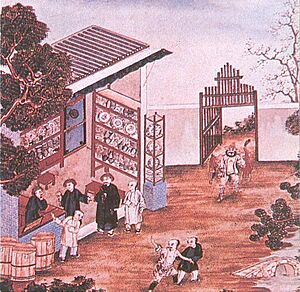History of Jiangxi facts for kids
The history of Jiangxi is very long, going back about one million years! People have lived in this area of China since the Lower Paleolithic (Old Stone Age). Scientists recently found the oldest known pottery in the world here, dating back to about 18,000 BC, in a place called Xianren Cave.
Around 8000 BC, the Neolithic period (New Stone Age) began in Jiangxi. People started farming, and they even grew rice over 10,000 years ago! Later, the Bronze Age began around 2000 BC, followed by the Iron Age before 500 BC.
The first people we know about in Jiangxi were called the Baiyue. Their language still influences the Gan Chinese dialects spoken today. Over time, different states like Wu, Yue, and Chu ruled Jiangxi. Around 200 BC, the Han dynasty of China took control.
Jiangxi is important because it's located in the Gan River valley, which was a main route for travel from north to south. Mountains surround the area, helping Jiangxi develop its own unique culture. This region was a key path from the North China Plain and the Yangzi River valley to modern Guangdong. Because of its location, Jiangxi has always been a very important place throughout history.
Contents
Ancient Times
During the Shang dynasty (from the 16th to 11th centuries BC), Jiangxi was not part of the main Chinese civilization. We don't have much information from this time, but we think the Yue people lived there.
Later, during the Spring and Autumn period, the northern part of Jiangxi was the western edge of the state of Wu. Two towns, Ai and Po, were known then. After the state of Wu was defeated in 473 BC by the state of Yue, the state of Chu took over northern Jiangxi. Chu then conquered Yue in 333 BC. Finally, the state of Qin conquered Chu in 221 BC. This led to the Qin dynasty, which was the first time China was united under one ruler.
Imperial China
When China was united under the Qin dynasty, Jiangxi became part of the Qin empire. The First Emperor of Qin created seven counties in Jiangxi. These were all managed from a main city called Jiujiang, which was north of the Yangzi River. Most of these cities were along the Gan River system. They were important for protecting the Qin routes to new lands in the south. These early Qin settlements formed the basic structure of Jiangxi that largely exists even today.
Han Dynasty Changes
The Yuzhang commandery was set up in northern Jiangxi at the start of the Han dynasty. This was around 200 BC. Over time, this area grew to have eighteen counties, covering most of what is now Jiangxi province. Many modern cities like Nanchang and Ganzhou are located where these ancient county seats once were.
Later Dynasties and New Names
In 291 AD, during the Western Jin dynasty, Jiangxi became its own special area called Jiangzhou. During the time of the Northern and Southern dynasties, Jiangxi was controlled by the southern dynasties, and more of these special areas were created.
During the Sui dynasty, Jiangxi had seven main areas and twenty-four smaller counties. The Tang dynasty added more. Then, a new top-level division called a "circuit" was created. Jiangxi was first part of the Jiangnan Circuit. In 733, this circuit was split into eastern and western parts. Jiangxi was in the western part, called Jiangnanxi Circuit. This is where the modern name "Jiangxi" comes from!
The Rise of Jiangxi Province
After the Tang dynasty ended in 907, China was divided into many smaller states. Jiangxi was part of the Wu state, and then the Southern Tang state. Both of these states were based near the Yangtze River.
During the Song dynasty, the Jiangnanxi Circuit was set up again. It had nine main areas and four military districts.
The Yuan dynasty was important because it was the first time "Jiangxi Province" was officially created. This new province also included most of what is now Guangdong. Jiangxi got its current borders during the Ming dynasty when Guangdong became a separate province. Since then, Jiangxi's borders have stayed mostly the same.
Modern Times
After the Qing dynasty ended, Jiangxi became an important place for the Communists. Many farmers joined their revolution. The Nanchang Uprising happened in Jiangxi on August 1, 1927, during the Chinese Civil War.
Later, the Communist leaders hid in the mountains of southern and western Jiangxi. They were trying to escape from the Kuomintang, who wanted to stop them. In 1931, the Communists declared Jiangxi's independence from the Republic of China. They called it the "Chinese Soviet Republic" and set up their capital in Ruijin, which is sometimes called the "Red Capital." In 1935, the Nationalist forces surrounded them, so the Communists broke through and began the famous Long March to Yan'an.
World War II Impact
During World War II, after the Doolittle Raid, many American airmen crashed in China. Chinese people helped them get to safety. However, the Imperial Japanese Army punished the Chinese very harshly for helping the Americans. The Japanese started the Zhejiang-Jiangxi Campaign to scare the Chinese. They killed about 250,000 civilians while looking for the American airmen.
See also
- Jiangxi Provincial Parliament


